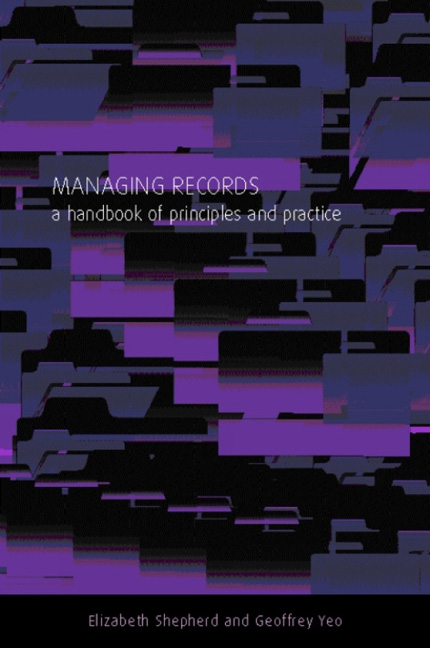Book contents
- Frontmatter
- Contents
- Preface
- Editorial note
- Introduction
- 1 Understanding records management
- 2 Analysing the context for records management
- 3 Classifying records and documenting their context
- 4 Creating and capturing records
- 5 Managing appraisal, retention and disposition
- 6 Maintaining records and assuring their integrity
- 7 Providing access
- 8 Implementing records management: practical and managerial issues
- Conclusion
- Appendix A Bibliography and sources of further information
- Appendix B Select list of national and international standards
- Appendix C Professional organizations for records managers in English-speaking countries
- Index
7 - Providing access
Published online by Cambridge University Press: 09 June 2018
- Frontmatter
- Contents
- Preface
- Editorial note
- Introduction
- 1 Understanding records management
- 2 Analysing the context for records management
- 3 Classifying records and documenting their context
- 4 Creating and capturing records
- 5 Managing appraisal, retention and disposition
- 6 Maintaining records and assuring their integrity
- 7 Providing access
- 8 Implementing records management: practical and managerial issues
- Conclusion
- Appendix A Bibliography and sources of further information
- Appendix B Select list of national and international standards
- Appendix C Professional organizations for records managers in English-speaking countries
- Index
Summary
Records are kept so that they can be made available to authorized users when required. Users may include the staff of the business unit where the records were created, other business units within the organization or authorized users from outside the organization.
At the time of their creation, records are normally accessible only to their creators and perhaps to other members of a workgroup. When they are captured into a records management system, they normally become more widely accessible: capture is often the moment when the existence of the records is publicized, although it may also be the point at which formal access controls are applied to protect confidentiality.
Since most organizations hold large numbers of records, systems must be in place to allow different users, and records management staff, to ascertain what records exist and to find those that are relevant to a particular need. Along with access control mechanisms, these need to be planned when records management programmes and systems are set up. This chapter examines the issues and offers some solutions to the questions of records retrieval.
Meeting the needs of users
Users and their requirements
In order to design effective retrieval systems, records managers need an understanding of user requirements. Users articulate requests for retrieval in a variety of ways. For example, they may state that:
• a particular record exists, and they want to see it
• a particular process or activity took place in the past, and they want to find evidence or information about it
• they are gathering information about a particular topic to support the activity that they are currently engaged on
• they are undertaking broadly based research, and want to see if the records contain material that may be relevant.
Most of these requests allow several degrees of uncertainty. Some users may know that a record exists and be able to identify it precisely; others may seek the same record but be ignorant or uncertain of its title or location. Users may know that an activity took place but have varying degrees of uncertainty about when it occurred, who participated in it or what records it gave rise to. Access mechanisms must be able to satisfy a range of users, including those who have little or no prior knowledge of the records.
In addition, retrieval systems must be able to handle records at different levels of aggregation.
- Type
- Chapter
- Information
- Managing Recordsa handbook of principles and practice, pp. 216 - 245Publisher: FacetPrint publication year: 2003



